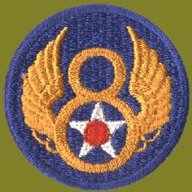
B-17 GSH 42-3486
MI D "INVICTUS" *
* Name Invictus not given in official documents [3]
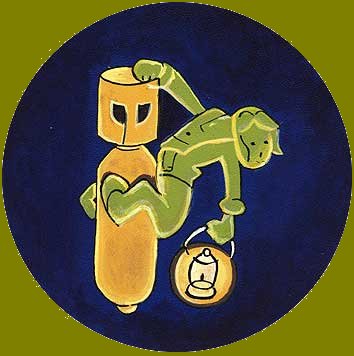
8th USAAF badge
812th BS badge
 |
B-17 GSH 42-3486 |
 |
|
8th USAAF badge |
812th BS badge |
Clearly an off-topic page for the motorcycle visitors, but maybe nice for those who are interested in WW2 aircraft.
|
Years ago I acquired a propellor blade of a B-17 bomber that had been
recovered from the Oostelijke Flevo polder after that part of the Zuiderzee/IJsselmeer was
diked and drained. The blade has been gathering dust for years by lack of suitable place to put it. The opportunity finally arose after moving house. As I now can display it, I want to find as much as possible about this particular aircraft. |
|
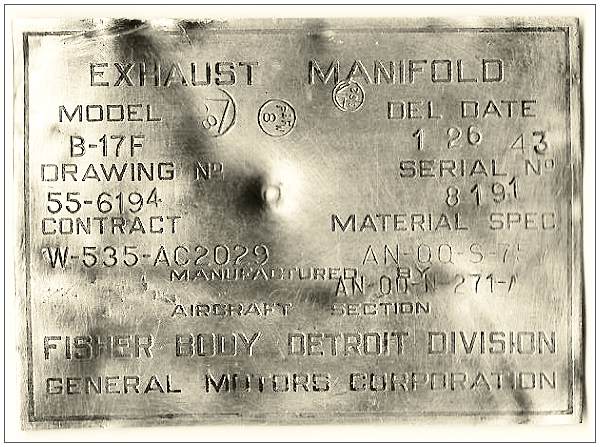 |
Exhaust Manifold serial plate of 42-3486 | |
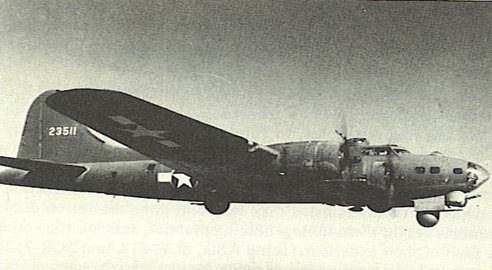 |
B-17 GSH 42-3511. One from the initial 12 H2X modified bombers. Picture probably taken in the USA or shortly after reaching GB. Code MI K not yet applied. 42-3486 (MI D) is expected to have looked similar. |
What I have gathered/deduced so far:
Aircraft was built as a B-17F-70-DL (F model, modification status block 70,
built by Douglas Long Beach)
with serial number 42-3486 and received by the Army Air Force on July 7th 1943.
It was built at the grand total cost of 330.297 US dollars!
After finishing it, it was flown to Rome Air Depot (NY state) via Tulsa (OK),
Denver (Co) and Gore Field (MT). At Rome, it was modified to a B-17G status
which included the addition of a twin MG chin turret and was re-designated as such.
[1].
During the period at Rome, it was also modified to carry the H2X "Mickey" airborne
radar.
See radar equipped B-17's
.
After the modification and initial training, 12 radar equipped aircraft were flown to England in September 1943 and based with the newly formed 482 Bomb Group (Pathfinders), consisting of 812th, 813th and 814th Bomb Squadrons on USAAF station 102 (Alconbury). 482nd BG was part of the 1st Air Division of the 8th Army Air Force [2].
42-3486 was assigned to the 812th Bomb Squadron (callsign "Lasthouse") which was led by Major Fred
Rabo.
In England, the airplane received the code MI D and the name Invictus [3]. Although
I have not been able to find a picture of this actual aircraft, I assume it was
still painted in the USAAF green with light grey undersides. Apparently, PFF
aircraft did not wear unit identification marks on the tail as seen on planes of other bomber
units. A German report [4] on the downed 42-3500 (coded MI J) to have carried
a yellow J under the 23500 code on the tail. This might be an indication that
the MI D code was yellow.
On Januari 11th 1944, the airplane started its last mission from
USAAF station 111 (Thurleigh) on a Pathfinder mission (high altitude bombing at
21.000 ft (6400 m) to destroy aeroplane manufacturing facilities in
Oschersleben/Halberstadt and Brunswick (mission no 182). Invictus led the 40th Composite Combat Wing (together
with another PFF plane, likely to have been 42-3491, commanded by Major Fred A. Rabo, 812 BS commander)
[5] to Halberstadt.
This day became one of worst for the USAAF. 60 B-17's and 2 B-24's did not come
home from their missions.
From here on, the story gets difficult to reconstruct.
Following the official reports (MACR, 812th BS diary entry for the 11th) I
would come to following deductions:
After bomb release and on its way back home, it was attacked and hit in the
tail, by (an) Anti Aircraft rocket(s) (fired by a German fighter?) (reported by one
of the survivers [3]).
The tail was severely damaged and the tail gunner was
either killed or badly wounded. There was no communication with him anymore before the
final crash. This rocket attack happened before 11:58 [6,8]. The
plane was apparently not able to stay in the formation as it was last reported
as being near the town of Hallendorf, about 6 miles South West of Braunschweig
[6].
According to this surviving crew member, the plane was still heading West
despite its serious damages and about 10 minutes from the (North Sea) coast,
when the fatal attack occurred with either gun or cannon rounds
killing/wounding the pilot and co-pilot. After this attack, the plane pitched up
steeply, stalled and finally fell over into the final dive from which it did not
recover.
Reading the story on the Caterpillar Club [11] application form of Euian C.
Mills, there is no mention of being hit before the final crash although it does
refer to the bombers having been under constant attacks since crossing the
mainland coast to the target and on the way back. "Near
the Dutch coast, a mass of German fighters, consisting of Fw 190's and Me 109's,
filed into rows of 6 to 8 planes in line, one above the other. They all
seemed to start firing at once. We were hit in the first wave, we nosed up into
a stall and fell nose forward." The form also mentions that "the plane was totally
out of control with 2 engines on fire falling at about 45° attitude" when he
bailed out.
Based on this last eyewitness report it seems that the MACR likely describes the
last sighting of another plane being hit between Oschersleben/Halberstadt and Hallendorf.
Confusing is that as a pathfinder usually leads a formation its difficult to
understand how following crews did not give a more accurate description on
either initial damage to the tail or the position/sighting of the aircraft
during the final attack.
Reading the story, it is certain that the crews were experiencing a high level
of adrenaline during the flight possibly leading to incorrect reporting
afterwards. Interrogation officers may also have made interpretation mistakes.
Another fact that may have caused confusion is that the plane did not belong to
the actual Combat Wing being led. It was therefore not a familiar plane within
the wing it led.
This also means that the story might not have been put together as first hand
account by the 812th BS but through information from the BGroups in the accompanying
Combat Wing.
The exact sequence of the flight may be shrouded in uncertainty for ever.
Only 4 members of the crew were able to bail out [3,7] before it
finally hit the water of the Zuiderzee/IJsselmeer, approximately 330° and 4.5
N.M. off the harbour of Harderwijk at about 13:30 [8]. It therefore crashed more
than 1 hour and 30 minutes minutes after the last official sighting
near Hallendorf .
Local witnesses told that the plane fell in flames through the overcast sky into
the Zuiderzee/IJsselmeer [9] on that cold Januari Tuesday.
At least 2 pilots have claimed this victory. Feldwebel Gerhard (Gerd) Wiegand
of Jagd Geschwader 4/26, an ace surviving the war with 32 claims on his credit,
and Oberleutenand Artur Beese of 1/JG26, an ace of 22 claims, killed in 1944.
Both claimed to have shot down a B-17 at 13:25 and a height of 5500 m (18.000
ft). Wiegand also claimed to have shot down another fortress on this day (42-37719 of
381BG, 533BS) at 13:28. Both attacks happened at a height of 5500 m. [10].
With so many fighter planes as reported by Mr Mills, is rather tricky to credit
a certain claim to one pilot.
The crew of Invictus on this final flight consisted of the following airmen [9]:
| Function | rank, name, identification number, status |
| Pilot | 1st Lt. James John Maginnis, USAAF 0-793803, KIA |
| Co-pilot | 1st Lt. Roy H. Peterson, USAAF 0-7354443, MIA, |
| Navigator | 1st Lt. Clarence E. Blevins, USAAF 0-800267, KIA |
| Bombardier | 1st Lt. George Clifford Wylie, USAAF 0-734410, KIA |
| Engineer, Top Turret Gunner | T/Sgt. William A. Glenn, USAAF 38099500, POW, |
| Radio operator | S/Sgt. Raymond H. Rajala, USAAF 11040263, POW, |
| Ball turret gunner | S/Sgt. Euian C. Mills, USAAF 35442731, POW, |
| Right waist gunner | S/Sgt. Angelo J. Riccardi, USAAF 17076910, KIA, |
| Left waist gunner | S/Sgt. Joseph P. Keane, USAAF 1288173, KIA, |
| Tail gunner | S/Sgt. Harry, C. Sutton, USAAF 18225931, KIA |
| 2nd Navigator | F/O John Joseph O'brien, USAAF T-190891, KIA |
Most of the Maginnis crew flew with 509 BS of the 351 BG until late October 1943 before being transferred to the newly formed 482nd BG.
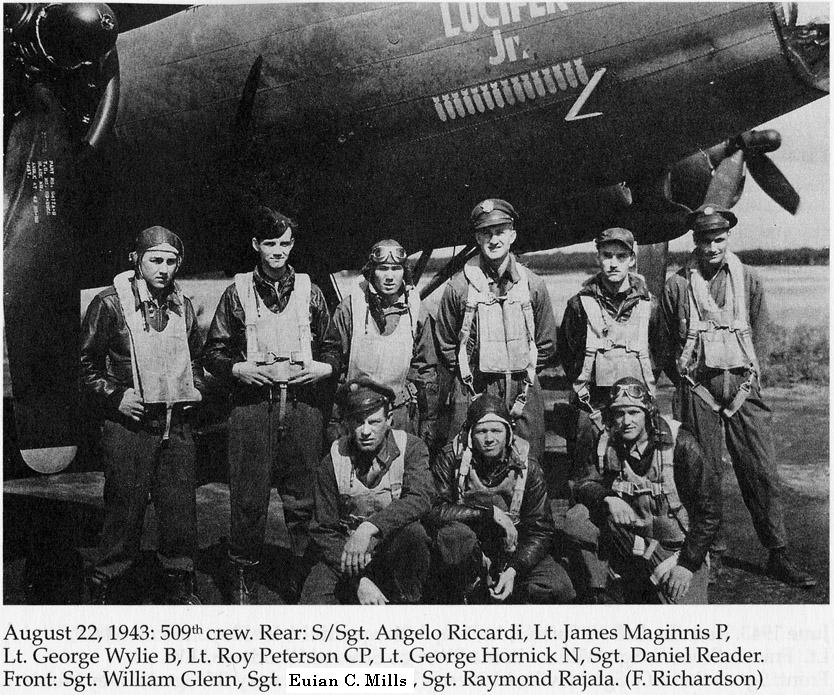
Lt. George Hornick and Sgt. Daniel Reader were not part of the final crew of
42-3486,
The plane Lucifer Jr was 43-xxxx
In the end, 3 of the crew of 11 survived the crash. For more details on the crew see what happened with the crew.
The other 9 were part of the over 26.000 American airmen killed in the European Theatre
of Operation!
The web pages are made with the information I have been able to gather so far.
I do not claim to have it absolutely correct as you have to "read between the
lines" in some instances, and internet sources seldom refer to their source of the
information.Without source reference to corroborate the story, its difficult to asses its
value.
| Notes: | |
| [1] | All shown on Aircraft History Card |
| [2] | Deduced from 482nd website, official 482 history and 812 BS diary |
| [3] | MI D code was given in the MACR 2522, the name Invictus comes from a document made by a Mr van der Woude, Eemnes, Holland, 1995. It has however not yet been confirmed by other sources. |
| [4] | Given in a German report on wreckage of 42-3500 as given in MACR 3159 |
| [5] | Official history of the 482 BG (Major F. Rabo was shot down over Berlin flying 42-3491 on March 6th 1944 and became POW). |
| [6] | Time and location of last visual contact by other airplane crews of the formation, given in MACR2522. |
| [7] | Eye witness account written in "Harderwijk in oorlogstijd" |
| [8] | The reported times are difficult to compare. English time and Dutch (German) times were not in line. |
| [9] | Wiegand was mentioned in newspaper articles in 1968/69 and shown on websites like military-art.com. Beese was mentioned by Gary Bullock, relative of Sgt Euian C. Mills, BT gunner, and also described on mentioned website. As this website does not give any reference to their sources its validity is uncertain. |
| [10] | All info from the MACR 2522, supplemented with info from the booklet "Harderwijk in oorlogstijd" and a document created by a Mr. van der Woude, Eemnes (see references) |
| [11] | The Caterpillar Club is an informal association of people who have successfully used a parachute to bail out of a disabled aircraft. Several parachute manufacturers have such form of momento. Mills was saved by an Irwin 18' chest pack |
The following references have been used to reconstruct this tragic event:
Copies of official USAAF documents via United States AFHSO Research:
Aircraft History Card
extracts from the official history of the 482 BG
extract from the 812 Bomb Squadron sq
Missing Air Crew Report MACR 2522 on 42-3486
MACR 3159 on 42-3500
AFPPA-11 individual Casualty questionaires
AFPPA-12 Casualty Questionaire
Books:
"In de schaduw van de glorie - Overzicht van
vliegtuigbergingen in Nederland 1960-1977", by S.L. Veenstra
"The mighty 8th", by Roger Freeman
"Harderwijk in oorlogstijd" by B.A. van Kuik, bewerkt door Liek Mulder
Newspaper article "Filmpje ontwikkeld na 26 jaar in de modder te hebben
gelegen", no date or newspaper name on it.
Various:
Document created in 1995 by a Mr van der Woude from Eemnes, Holland obtained via Militair Luchtvaart Museum (Dutch
Military Aviation Museum
in Soesterberg, the Netherlands)
Copy of the Caterpillar Club application form as written for Euian C. Mills in
1984, courtesy of Mr Gary Bullock, Son-in-law of S/Sgt Euian C. Mills.
E mail contacts with the American Battle Monuments Commision
E mail communication with Teunis Schuurman - aka - "PATS" from the Pats homepage
(see below) who also kindly allowed me to use some pictures of the airmen and
the graves located in the USA. Picture of Exhaust manifold from Bert Wijs, via
"PATS" website.
Internet websites:
http://www.teunispats.nl/fr-wwii.htm and for 42-3486 specific
http://www.teunispats.nl/t3307.htm
http://www.482nd.org/
http://oralhistory.rutgers.edu/Docs/diaries/wartime_diaries_of_edward_c_piech/chapter_four_piech_diaries.html
http://www.8thafhs.org/index.htm
http://www.gallery.mighty8thaf.preller.us/main.php
http://www.footnote.com
http://www.military-art.com/mall/default.php
http://www.taphilo.com/history/8thaf
http://mighty8thaf.preller.us/php/1Unit.php?Unitkey=1054
http://351st.org/
forums:
http://forum.armyairforces.com